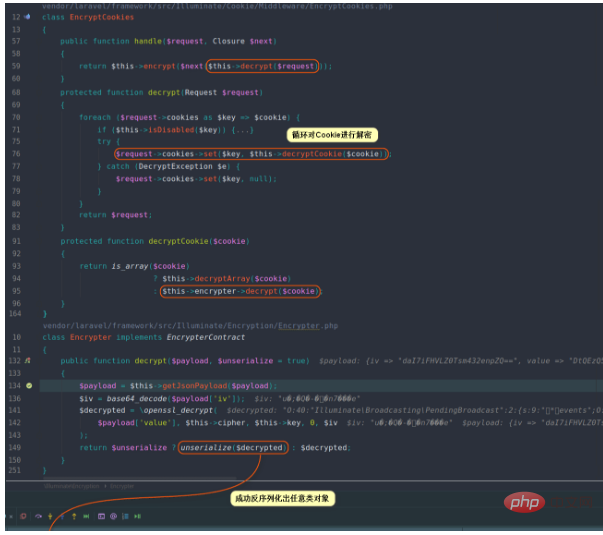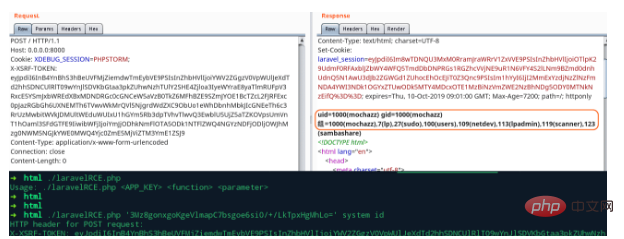The following tutorial column is developed by Laravel to introduce you to Laravel's method of repairing website vulnerabilities. I hope it will be helpful to friends in need!

The Laravel framework is a development framework currently used by many websites and APP operators. Because there are so many websites used, many attackers are constantly attacking We conducted vulnerability testing on the website. When we conducted vulnerability testing on the system, we found that there was a REC vulnerability. It was mainly an XSRF vulnerability. Let's analyze the vulnerability in detail, how to exploit it, and how to fix it. Record.
The exploitation of this Laravel REC vulnerability requires conditions. The APP_KEY must be leaked before it can be successfully exploited and triggered. Our SINE security technology discovered a total of There are two places where website vulnerabilities can occur. The first is the cookies field in the Post packet, and the other is the HTTP header field where malicious total code can be inserted into the website backend.
Let’s build it Let’s take a look at the environment for website vulnerability testing. We use linux centos system, PHP5.5 version, the database is mysql, and it is built using apache environment. The Laravel version used is 5.6.28. First, we go to the official website to download the version and unzip it to the apache setting. Website directory path. First of all, in our post data, we can see that in our code, we will call more than a dozen classes, call objects in the classes, and assign parameters. In the cookies and verifycsrftoken values, we found that app_key can be used for vulnerability exploitation. First we use cookies to reproduce it:

The code is as follows:
POST / HTTP/1.2 Host: 127.0.0.2:80 Cookie: safe_SESSION=PHPSTORM; 5LqG5L+d6K+B5omA6L6T5Ye655qE57yW56CB5L2N5Y+v6K+75a2X56ym77yMQmFzZTY05Yi25a6a5LqG5LiA5Liq57yW56CB6KGo77yM5Lul5L6/6L+b6KGM57uf5LiA6L2s5o2i44CC57yW56CB6KGo55qE5aSn5bCP5Li6Ml42PTY077yM6L+Z5Lmf5pivQmFzZTY05ZCN56ew55qE55Sx5p2l44CCDQoNCkJhc2U2NOe8lueggeihqA==; Content-Type: application/x-www-form- Connection: open Content-Length: 1
The above code is in the cookies column. The encrypted value is what we want The forged attack code submits the POST request to the website. It will first decrypt the APP_key and assign it a value. If the decryption is successful, the value in the cookies will be verified and deserialized, and then If the vulnerability occurs, the RCE vulnerability will be triggered.
Let’s test the vulnerability using the http header method. First, we will construct a code similar to cookies, as follows:
POST / HTTP/1.2 Host: 127.0.0.2:80 X-XSRF-TOKEN: +B5omA6L6T5Ye655qE57yW56CB5L2N5Y+v6K+75a2X56ym77yMQmFzZTY05Yi25a6a5LqG5LiA5Liq57yW56CB6KGo77yM5Lul5L6/6L+b6KGM57uf5LiA6L2s5o2i44CC57yW56CB6KGo55qE5aSn5bCP5Li6Ml42PTY077yM6L+Z5Lmf5pivQmFzZTY05ZCN56ew55qE55Sx5p2l44CCDQoNCkJhc2U2NOe8lueggeihqA==; Content-Type: application/x-www-form- Connection: open Content-Length: 1

Look here at the X-XSRF-TOKEN: value. The Laravel framework will judge and verify this value during the submission process. If the decryption is successful, the deserialization operation will be performed. I won’t go through it one by one here. Introduction and explanation.
How to fix Laravel's vulnerability?
Our SINE security technology upgraded the Laravel version and found that the latest 5.6.30 version has the rce vulnerability Repairs have been made. From our code comparison, we can see that the decryption and parsing operations of cookies have been judged, and the static::serialized() value has been written more. This is also added to X-XSRF-TOKEN. Value. If you don’t know much about the code, you can also find a professional website security company to repair it. This is the website vulnerability detection and testing for Laravel. I also hope that through this sharing, more people can understand it. Website vulnerabilities, the causes of vulnerabilities, and how to fix them. Only when the website is safe can we open up our hands and feet to develop the market and do a good job in marketing.
The above is the detailed content of How Laravel fixes website vulnerabilities. For more information, please follow other related articles on the PHP Chinese website!

Hot AI Tools

Undress AI Tool
Undress images for free

Undresser.AI Undress
AI-powered app for creating realistic nude photos

AI Clothes Remover
Online AI tool for removing clothes from photos.

Clothoff.io
AI clothes remover

Video Face Swap
Swap faces in any video effortlessly with our completely free AI face swap tool!

Hot Article

Hot Tools

Notepad++7.3.1
Easy-to-use and free code editor

SublimeText3 Chinese version
Chinese version, very easy to use

Zend Studio 13.0.1
Powerful PHP integrated development environment

Dreamweaver CS6
Visual web development tools

SublimeText3 Mac version
God-level code editing software (SublimeText3)

Hot Topics
 How to create Laravel package (Package) development?
May 29, 2025 pm 09:12 PM
How to create Laravel package (Package) development?
May 29, 2025 pm 09:12 PM
The steps to create a package in Laravel include: 1) Understanding the advantages of packages, such as modularity and reuse; 2) following Laravel naming and structural specifications; 3) creating a service provider using artisan command; 4) publishing configuration files correctly; 5) managing version control and publishing to Packagist; 6) performing rigorous testing; 7) writing detailed documentation; 8) ensuring compatibility with different Laravel versions.
 What is Middleware in Laravel? How to use it?
May 29, 2025 pm 09:27 PM
What is Middleware in Laravel? How to use it?
May 29, 2025 pm 09:27 PM
Middleware is a filtering mechanism in Laravel that is used to intercept and process HTTP requests. Use steps: 1. Create middleware: Use the command "phpartisanmake:middlewareCheckRole". 2. Define processing logic: Write specific logic in the generated file. 3. Register middleware: Add middleware in Kernel.php. 4. Use middleware: Apply middleware in routing definition.
 Laravel Page Cache Policy
May 29, 2025 pm 09:15 PM
Laravel Page Cache Policy
May 29, 2025 pm 09:15 PM
Laravel's page caching strategy can significantly improve website performance. 1) Use cache helper functions to implement page caching, such as the Cache::remember method. 2) Select the appropriate cache backend, such as Redis. 3) Pay attention to data consistency issues, and you can use fine-grained caches or event listeners to clear the cache. 4) Further optimization is combined with routing cache, view cache and cache tags. By rationally applying these strategies, website performance can be effectively improved.
 Laravel MVC Architecture: what can go wrong?
Jun 05, 2025 am 12:05 AM
Laravel MVC Architecture: what can go wrong?
Jun 05, 2025 am 12:05 AM
Laravel'sMVCarchitecturecanfaceseveralissues:1)Fatcontrollerscanbeavoidedbydelegatinglogictoservices.2)Overloadedmodelsshouldfocusondataaccess.3)Viewsshouldremainsimple,avoidingPHPlogic.4)PerformanceissueslikeN 1queriescanbemitigatedwitheagerloading.
 How to populate test data using Seeder in Laravel?
May 29, 2025 pm 09:21 PM
How to populate test data using Seeder in Laravel?
May 29, 2025 pm 09:21 PM
Using Seeder to fill test data in Laravel is a very practical trick in the development process. Below I will explain in detail how to achieve this, and share some problems and solutions I encountered in actual projects. In Laravel, Seeder is a tool used to populate databases. It can help us quickly generate test data, which facilitates development and testing. Using Seeder not only saves time, but also ensures data consistency, which is especially important for team collaboration and automated testing. I remember that in a project, we needed to generate a large amount of product and user data for an e-commerce platform, and Seeder came in handy at that time. Let's see how to use it. First, make sure your Lara is
 What is Laravel Migrations? How to use it?
May 29, 2025 pm 09:24 PM
What is Laravel Migrations? How to use it?
May 29, 2025 pm 09:24 PM
Laravel's migration is a database version control tool that allows developers to programmatically define and manage database structure changes. 1. Create a migration file using the Artisan command. 2. The migration file contains up and down methods, which defines the creation/modification and rollback of database tables respectively. 3. Use the phpartisanmigrate command to execute the migration, and use phpartisanmigrate:rollback to rollback.
 Laravel: Simple MVC project for beginners
Jun 08, 2025 am 12:07 AM
Laravel: Simple MVC project for beginners
Jun 08, 2025 am 12:07 AM
Laravel is suitable for beginners to create MVC projects. 1) Install Laravel: Use composercreate-project--prefer-distlaravel/laravelyour-project-name command. 2) Create models, controllers and views: Define Post models, write PostController processing logic, create index and create views to display and add posts. 3) Set up routing: Configure/posts-related routes in routes/web.php. With these steps, you can build a simple blog application and master the basics of Laravel and MVC.
 What are policies in Laravel, and how are they used?
Jun 21, 2025 am 12:21 AM
What are policies in Laravel, and how are they used?
Jun 21, 2025 am 12:21 AM
InLaravel,policiesorganizeauthorizationlogicformodelactions.1.Policiesareclasseswithmethodslikeview,create,update,anddeletethatreturntrueorfalsebasedonuserpermissions.2.Toregisterapolicy,mapthemodeltoitspolicyinthe$policiesarrayofAuthServiceProvider.






